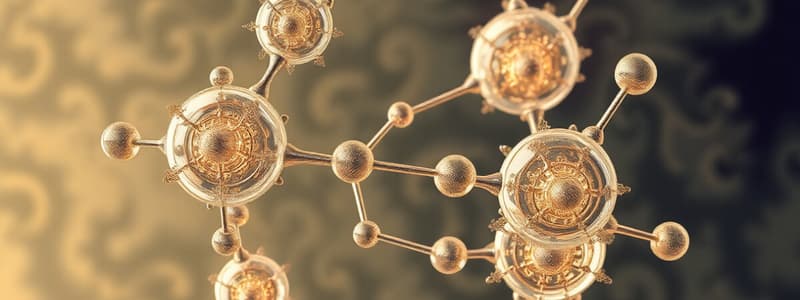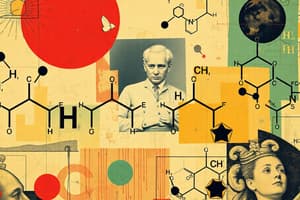Podcast
Questions and Answers
Which type of bond is characterized by a difference in electronegativities of more than 2 units?
Which type of bond is characterized by a difference in electronegativities of more than 2 units?
- Hydrogen bonds
- Ionic bonds (correct)
- Polar covalent bonds
- Metallic bonds
What primarily influences the properties of organic compounds?
What primarily influences the properties of organic compounds?
- Chemical stability
- Intermolecular forces of attraction (correct)
- Atomic mass
- Molecular weight
Which of the following effects refers to the distortion of an electron cloud?
Which of the following effects refers to the distortion of an electron cloud?
- Hybridization
- Steric effects
- Resonance
- Inductive effects (correct)
What term describes the distribution of electrons throughout an entire molecule?
What term describes the distribution of electrons throughout an entire molecule?
Which of the following types of chemical reactions involves the disruption and formation of chemical bonds?
Which of the following types of chemical reactions involves the disruption and formation of chemical bonds?
What type of geometry does carbon dioxide exhibit?
What type of geometry does carbon dioxide exhibit?
Which forces are commonly identified as van der Waals forces?
Which forces are commonly identified as van der Waals forces?
What factor primarily determines the strength of dipole-dipole interactions?
What factor primarily determines the strength of dipole-dipole interactions?
Which statement accurately describes hydrogen bonding?
Which statement accurately describes hydrogen bonding?
What is the relationship between molecular mass and London dispersion forces?
What is the relationship between molecular mass and London dispersion forces?
Which type of molecular interaction is solely exhibited by polar compounds?
Which type of molecular interaction is solely exhibited by polar compounds?
What characteristic of ammonia affects its molecular geometry?
What characteristic of ammonia affects its molecular geometry?
Which of the following statements about dipole moments is true?
Which of the following statements about dipole moments is true?
What type of bond involves the complete transfer of electrons from one atom to another?
What type of bond involves the complete transfer of electrons from one atom to another?
Which characteristic of carbon allows it to form a variety of compounds?
Which characteristic of carbon allows it to form a variety of compounds?
What determines the polarity of a molecule?
What determines the polarity of a molecule?
What type of interaction is primarily responsible for the physical properties of substances?
What type of interaction is primarily responsible for the physical properties of substances?
Which of the following groups of elements commonly form ionic bonds?
Which of the following groups of elements commonly form ionic bonds?
What is the outcome of polar covalent bonding?
What is the outcome of polar covalent bonding?
What is a common feature of substances with high solubility in polar solvents?
What is a common feature of substances with high solubility in polar solvents?
What type of bond results from the sharing of electrons between two atoms?
What type of bond results from the sharing of electrons between two atoms?
What shape does the molecular structure of H2O possess?
What shape does the molecular structure of H2O possess?
Which type of intermolecular force is strongest in ionic organic compounds?
Which type of intermolecular force is strongest in ionic organic compounds?
What characteristic is associated with London Dispersion Forces?
What characteristic is associated with London Dispersion Forces?
What is the main factor that determines the high boiling point of sodium acetate?
What is the main factor that determines the high boiling point of sodium acetate?
Which property is considered one of the most important for organic compounds?
Which property is considered one of the most important for organic compounds?
What must be overcome during the melting of an ionic compound?
What must be overcome during the melting of an ionic compound?
How are isomers defined?
How are isomers defined?
Why do ionic compounds form a well-ordered crystalline structure?
Why do ionic compounds form a well-ordered crystalline structure?
What type of isomerism describes compounds with the same molecular formula but different carbon skeletons?
What type of isomerism describes compounds with the same molecular formula but different carbon skeletons?
Which type of functional groups exemplifies alcohol and ether?
Which type of functional groups exemplifies alcohol and ether?
In trans isomerism, how are the functional groups arranged in relation to the double bond?
In trans isomerism, how are the functional groups arranged in relation to the double bond?
What is a key characteristic of stereoisomerism?
What is a key characteristic of stereoisomerism?
Which type of evidence supports the concept of vitalism?
Which type of evidence supports the concept of vitalism?
What process was responsible for the synthesis of urea, supporting biochemical evolution?
What process was responsible for the synthesis of urea, supporting biochemical evolution?
Which type of isomerism is characterized by a change in the position of functional groups within the molecule?
Which type of isomerism is characterized by a change in the position of functional groups within the molecule?
What distinguishes conformational isomerism from other forms of isomerism?
What distinguishes conformational isomerism from other forms of isomerism?
Flashcards are hidden until you start studying
Study Notes
### Chemical Bonds
- Ionic bonds occur when electrons transfer from one atom to another resulting in the production of charged atoms called ions.
- Covalent bonds occur when electrons are shared between two atoms.
- Covalent bonds can be polar or non-polar.
Properties of Organic Compounds
- Influenced by intermolecular forces of attraction, molecular geometry, and structural effects.
- Structural effects include, orbital hybridization, steric effects, inductive effects, resonance, and hyperconjugation.
### Molecular Polarity
- Based on the distribution of electrons across the entire molecule.
### Intermolecular Forces of Attraction (IMFA)
- Attractive forces between molecules which must be overcome during melting, evaporation, and sublimation.
- Types of IMFA:
- London Dispersion Forces (LDF): Present in all substances, only IMFA present in non-polar substances and noble gases.
- Dipole-Dipole Forces: Present only in polar compounds, strength increases with increased molecule polarity.
- Hydrogen Bonding: Strong IMFA, a special type of dipole-dipole force.
- Ion-Ion Forces: Present in ionic organic compounds, strong due to electrostatic lattice forces.
Isomerism
- Compounds with the same molecular formula but different structural formulas.
- Two types:
- Structural Isomerism: Variations in the bonding arrangement of atoms or groups.
- Skeletal isomerism: Different carbon skeleton.
- Positional isomerism: Same functional group with different positions.
- Functional isomerism: Same molecular formula with different functional groups.
- Stereoisomerism: No variations in bonding arrangement, only in orientation in space.
- Geometric isomerism: Variations in the spatial arrangement of atoms or groups due to the presence of a double bond or a ring.
- Cis: Functional groups on the same side of a double bond (generally has a bent structure).
- Trans: Functional groups on opposite sides of a double bond (generally has a linear structure).
- Conformational isomerism: Rotations around single bonds that result in different spatial arrangements.
- Geometric isomerism: Variations in the spatial arrangement of atoms or groups due to the presence of a double bond or a ring.
- Structural Isomerism: Variations in the bonding arrangement of atoms or groups.
Origins of Life
- Vitalism theory: Living organisms do not behave according to the known laws of physics and chemistry.
- Evidence against vitalism: Urea, an organic compound, was synthesized by heating the inorganic compound ammonium cyanate in 1828.
- This evidence suggests that biochemical processes, such as formation of organic compounds, can also occur outside of living organisms.
Studying That Suits You
Use AI to generate personalized quizzes and flashcards to suit your learning preferences.




